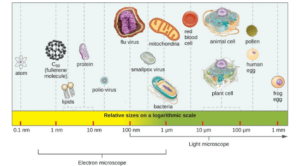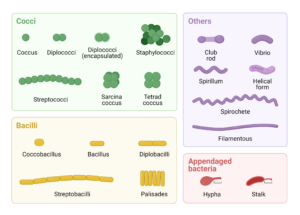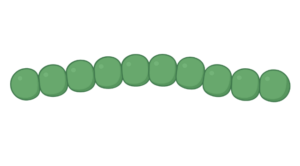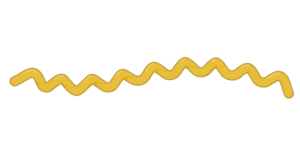Morphology of Bacteria
- Bacteria are a sort of unicellular prokaryotic biological cell. Since they lack a membrane-bound nucleus, they are simpler than other forms of living creatures.
- Even though simply a few can be seen with the human eye and the rest are minuscule, they come in a variety of shapes, sizes, and architectures.
Bacterial Size
- The micron (micrometre) is a one-thousandth of a millimetre unit of measurement used in bacteriology.
- Bacteria are about a tenth of the size of eukaryotic cells. Bacteria range in size from 0.5 to 5 m on average.
- They can, however, be as little as 0.3 m and as large as 0.7 mm.
- The unaided eye’s resolution limit is roughly 200 microns, and because numerous germs are lesser than this, they are invisible to the uncovered eye.
The biggest bacteria are Thiomargarita namibiensis, that may raise to be half a millimetre long, and Epulopiscium fishelsoni, that can raise to be 0.75 millimetres long.
Mycoplasma bacteria are the tiniest bacteria, measuring about 0.3 m in length and as minuscule as the tiniest viruses.
- Common bacteria, such as Escherichia coli, have a diameter of 1.1 to 1.5 m.
- Bacterial size has been shown to have a substantial impact on their ability to survive.
- Due to their small size, they may live and even thrive in a range of unexpected habitats, such as vertical sediments in the marine surrounding.
- Bacteria can take use of the nutrients available because other species aren’t present.
- Furthermore, bacteria’s small size encourages parasitism and the capacity to thrive in low-nutrient environments.
- The bacteria’s high surface area-to-volume ratio also enables them to receive all of the nutrients they require while continuing to grow and reproduce.
Shape of Bacteria
- The bulk of bacteria contain a strong cell wall which protects their internal components while also giving them a defined form.
- Even while the bulk of bacteria have this trait, they range in shape, allowing them to be categorised in diverse categories depending on their morphologies.
- The cytoskeleton and cell wall of bacteria are responsible for the broad diversity of shapes.
- Despite the fact that bacteria exist in a vast range of shapes, each genus usually only has a few morphologies, implying that given a universe of shapes to pick from, bacteria simply take on the most adaptable.
- Bacteria of various types exhibit a variety of physical traits to the outside environment, which let cells deal with and adjust to external conditions.
- Bacterial morphology has been discovered to add a measure of continued existence value in the face of food acquirement, cell division, predators, accessory to surfaces, submissive dispersion, dynamic motility, and internal or exterior differentiation.
Bacteria are classified into the following groups depending on their shapes:
Cocci
- In the human intestine, cocci bacteria are oval or spherical bacteria.
- These can be single or linked to one another in a group. When grouped together, they appear flattened.
- Coccoid forms are said to have evolved from rod-shaped animals all the way through evolutionary processes.
Bacilli (Rod-shaped)
- Bacilli are rod-shaped cells which, like cocci, can exist alone or else in association with other cells.
- Bacilli bacteria were amid the initial to appear, and their structure is regarded to be less conducive to growth than that of other bacteria. This is based on observations of filamentous E. coli cells, that travel gradually and cannot stumble to alter direction while being motile and chemotactic.
Spiral
- This category comprises microorganisms with helical or curved shapes (comma-shaped).
- The bacterium can have a corkscrew-like spiral or be slightly bent.
Cocci Arrangements
- Cocci bacteria can be categorised as singles, pairs, four-cell groupings, chains, clusters, or eight-cell cubes.
- During cell division, these cells stay together.
Coccus
- Bacteria that exist as a single cell are included in this category.
Diplococci
- This shape arises when two bacterial cells form a pair (connected jointly).
- In this arrangement, a few of the cells are spherical, while others are compressed, stretched out, or bean-shaped.
- Others include Streptococcus pneumoniae, Moraxella catarrhalis, Enterococcus spp., and Neisseria gonorrheae.
Tetrad
- Tetrad bacteria live within a cluster of four cells which stay together during cell division and thrive there.
- The cells split into two planes, resulting in this structure.
- Aerococcus, Pediococcus, and Tetragenococcus are some examples.
Sarcina
- The bacterial cells form an eight-cell cluster in this configuration.
- When cells divide in a perpendicular plane, this occurs.
- A general feature of these species is that they are strict anaerobes.
- Sarcina aurantiaca, Sarcina lutea, and Sarcina ventriculi are among examples.
Streptococci
- In streptococci, bacteria are placed in long strings.
- Streptococci bacteria belong to the Streptococcaceae family, which is characterised by Gram-positive bacteria and a lack of motility.
- Streptococcus pyogenes, Streptococcus pneumoniae, and Streptococcus mutans are some examples.
Staphylococci
- Bacteria clustered in grape-like clusters make up this kind.
- This is characterised by immotile and Gram-positive organisms and is caused by cell division in both planes.
- Staphylococcus bacteria comprise Staphylococcus haemolyticus, Staphylococcus epidermidis, Staphylococcus capitis and Staphylococcus aureus.
Bacilli Arrangement
Bacillus
- Bacilli are rod-shaped bacteria that live in solitary cells.
- These bacteria are facultative anaerobes that can create endospores.
- Some examples include Bacillus cereus, Salmonella enterica subsp., and Salmonella choleraesuis.
Diplobacilli
- Diplobacilli, like Diplococci, are found in pairs.
- The two cells do not divide and develop in a coordinated manner after cell division.
- Coxiella burnetii, Klebsiella rhinoscleromatis, and Moraxella bovis are among other instances.
Streptobacilli
- Bacteria in this category are organised in chains.
- This happens when a single chain of cells divides.
- Streptobacillus moniliformis, Streptobacillus Levaditi, Streptobacillus felis, and Streptobacillus hongkongensis are examples of streptobacilli.
Coccobacilli
- Coccobacilli are similar to both cocci and bacilli, as their name suggests.
- Because they are smaller, they appear stumpy.
- Haemophilus influenza, Chlamydia trachomatis, Gardnerella vaginalis are among examples.
Pallisades
- Pallisades are bacilli bacteria which have a picket fence-like structure due to a bend in the cell division point.
- They have the appearance of Chinese characters.
- Diphtheria is caused by the bacteria Corynebacterium diphtheria.
Spiral Arrangement
Vibrio
- These are the comma-shaped bacteria that are slightly bent.
- Vibrio mytili, Vibrio anguillarum, Vibrio parahaemolyticus, and Vibrio cholera are some examples.
Spirochetes
- Spirochetes are spiral bacteria with a helical structure.
- They’re flexible plus contain an axial filament to help with mobility. Spirochetes are distinguished from other bacteria by their filaments, which are a fundamental trait.
- The bacteria’s twisted movement is aided by these filaments, which run the length of the bacteria.
- Leptospira species (Leptospira interrogans), Treponema pallidum, and Borrelia recurrentis are all examples.
Spirilla (Helical-shaped/Corkscrew form)
- Spirochetes contain a similar structure to these bacteria, although they are more stiff.
- They, like spirochetes, contain a flagellum, however they are short of the endoflagella.
- Some examples are Campylobacter jejuni, Helicobacter pylori, and Spirillum winogradskyi.
Other Arrangements and Shapes
Appendaged Bacteria
- Bacteria with appendages, such as pillus or fimbriae, have a unique structure.
- Those that produce these appendages are more virulent than bacteria that do not.
- The agent of Gonorrhea, for example, is Neisseria gonorrheae.
Box-shaped/ Rectangular Bacteria
- Germs with a rectangular shape that resembles a box are known as box-shaped bacteria.
- Take, for example, Haloarcula marismortui.
Club-shaped Rod Bacteria
- Club –shaped rod bacteria contain one side that is narrower than the other.
- Corynebacterium is a well-known representative of this category.
Filamentous Bacteria
- These bacteria have a filamentous morphology and are long, thin, and filamentous.
- They can split into mycelium–like branches that resemble hair or spaghetti strands.
- A good example is actinomycetes.
Triangular-shaped Bacteria
- Bacteria with a triangular form belong to this group.
- Haloarcula is a good example.
Pleomorphic Bacteria
- This category involves bacteria that do not have a defined form.
- They can change shape, although they appear to have a distinct morphology in pure cultivation.
- Mycoplasma pneumoniae and Mycoplasma genitalium are two examples.
Stalked Bacteria
- This is a bacterial species with a stalk over one edge of the cell.
- Caulobacter crescentus, for example.
Star-shaped Bacteria
- This category involves microorganisms which resemble or are shaped like stars.
- Stella humosa is an example.
Morphology of Bacteria Citations
- Al-mohanna, Moshtaq & H., quine. (2016). MORPHOLOGY AND CLASSIFICATION OF BACTERIA.
- Constantino MA et al.(2016). Helical and rod-shaped bacteria swim in helical trajectories with little additional propulsion from helical shape. Science Advances. DOI: 10.1126/sciadv.1601661
- Image created using Biorender.com
- https://www.microscopemaster.com/bacteria-size-shape-arrangement.html
- http://europepmc.org/articles/PMC2169503
- https://www.ncbi.nlm.nih.gov/pmc/articles/PMC2169503/
- https://microbiologyinfo.com/different-size-shape-and-arrangement-of-bacterial-cells/
- https://www.difference.wiki/staphylococcus-vs-streptococcus/
- https://www.cs.mcgill.ca/~rwest/wikispeedia/wpcd/wp/b/Bacteria.htm
- https://brainly.com/question/8574377
- https://www2.palomar.edu/users/warmstrong/lmexer1.htm
- https://www.thoughtco.com/three-domain-system-373413
- https://www.studyread.com/classification-of-bacteria/
- https://www.sciencedirect.com/topics/medicine-and-dentistry/staphylococcus-saprophyticus
- https://www.sciencedirect.com/topics/biochemistry-genetics-and-molecular-biology/promoter-structure
Related Posts
- Phylum Porifera: Classification, Characteristics, Examples
- Dissecting Microscope (Stereo Microscope) Definition, Principle, Uses, Parts
- Epithelial Tissue Vs Connective Tissue: Definition, 16+ Differences, Examples
- 29+ Differences Between Arteries and Veins
- 31+ Differences Between DNA and RNA (DNA vs RNA)
- Eukaryotic Cells: Definition, Parts, Structure, Examples
- Centrifugal Force: Definition, Principle, Formula, Examples
- Asexual Vs Sexual Reproduction: Overview, 18+ Differences, Examples
- Glandular Epithelium: Location, Structure, Functions, Examples
- 25+ Differences between Invertebrates and Vertebrates
- Lineweaver–Burk Plot
- Cilia and Flagella: Definition, Structure, Functions and Diagram
- P-value: Definition, Formula, Table and Calculation
- Nucleosome Model of Chromosome
- Northern Blot: Overview, Principle, Procedure and Results
































